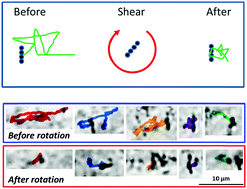Impact of a mechanical shear stress on intracellular trafficking†
Abstract
Intracellular trafficking mainly takes place along the microtubules, and its efficiency depends on the local architecture and organization of the cytoskeletal network. In this work, the cytoplasm of stem cells is subjected to mechanical vortexing at a frequency of up to 1 Hz, by using magnetic chains of endosomes embedded in the cell body, in order to locally perturb the network structure. The consequences are evaluated on the directionality and processivity of the spontaneous motion of endosomes. When the same chains are used both to shear the cell medium and to probe the intracellular traffic, a substantial decrease in transport efficiency is detected after applying the mechanical shear. Interestingly, when using different objects to apply the shear and to probe the spontaneous motion, no alteration of the transport efficiency can be detected. We conclude that shaking the vesicles mainly causes their unbinding from the cytoskeletal tracks, but has little influence on the integrity of the network itself. This is corroborated by active microrheology measurements, performed with chains actuated by a magnetic field, and showing that the mechanical compliance of the cytoplasm is similar before and after slow vortexing.



 Please wait while we load your content...
Please wait while we load your content...